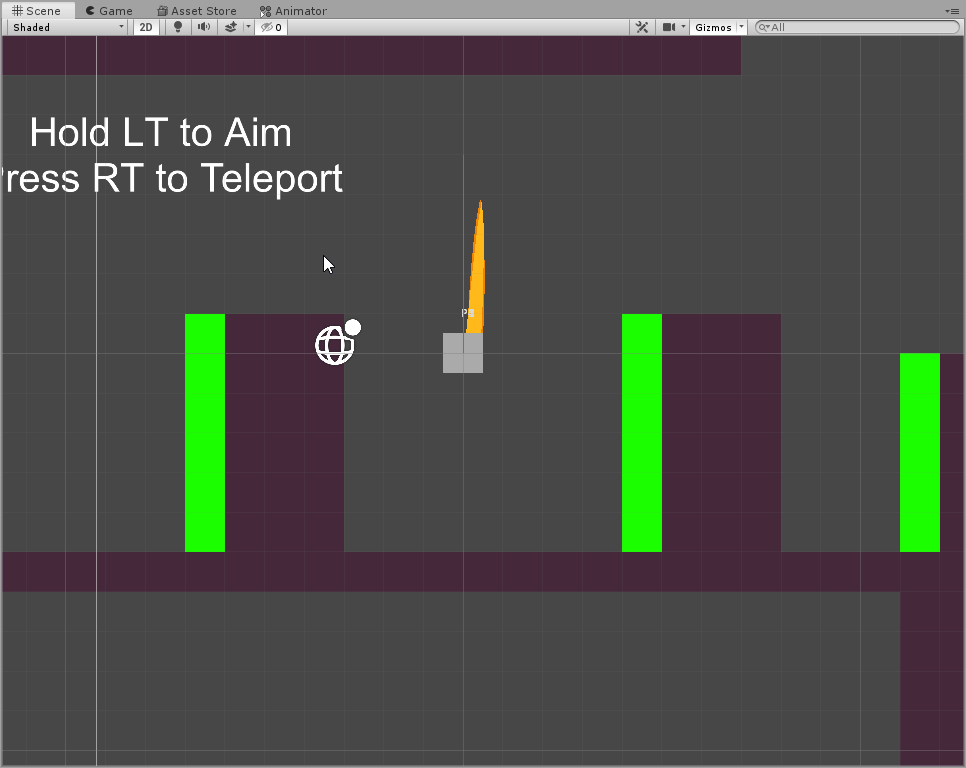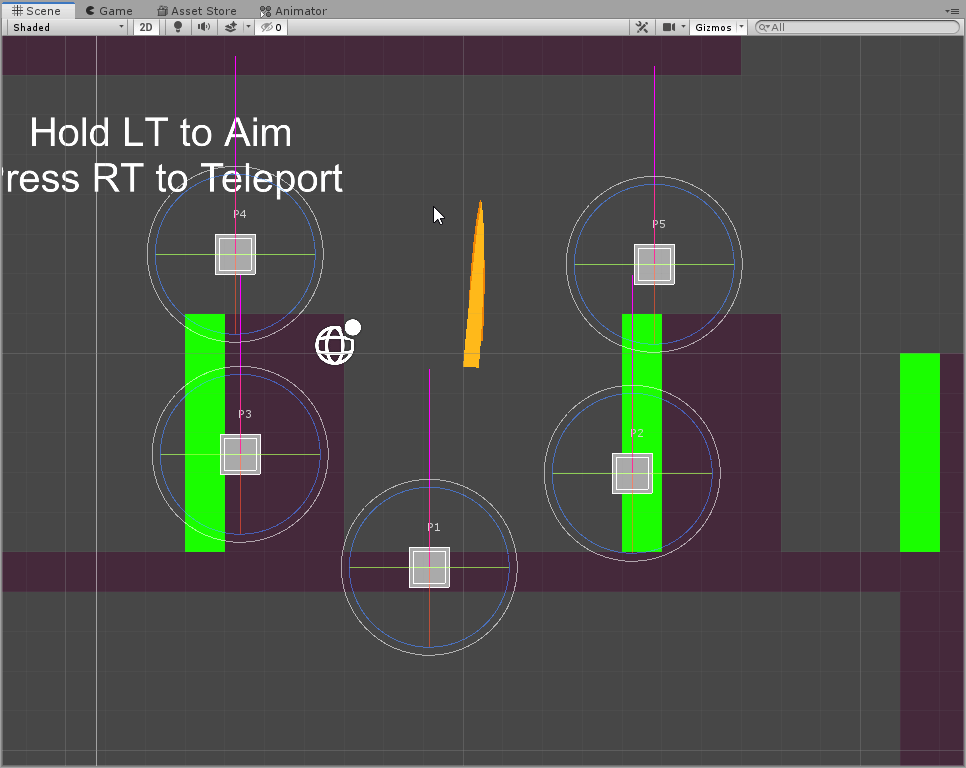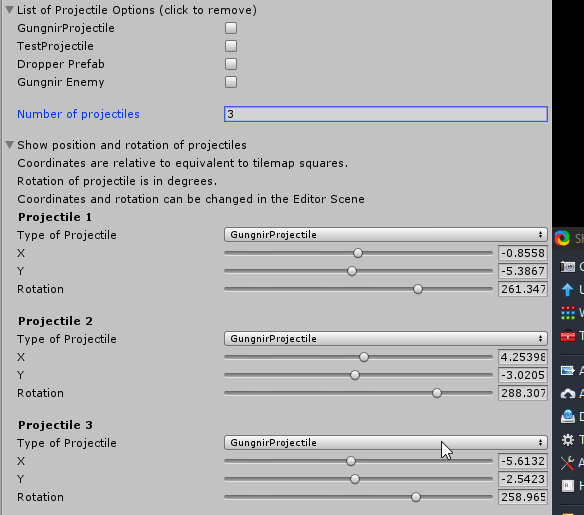Io Dev Blog 2
February 17th, 2020 ~ March 1st, 2020
Further developing editor tools to allow direct modification of data through scene gizmos.

Boss Attack Editor and Extended ScriptableObject Functionality
After creating the basic functionality of the Boss Attack ScriptableObject in the previous sprint, my task this sprint was
to add functionality such as allowing somebody to delete prefabs from the list of projectile prefabs through the editor,
without having to delete and recreate the ScriptableObject, allowing the type of projectile being instantiated to be chosen
for each instance, and allowing the position and rotation of each projectile to be changed by dragging around a gizmo in
the scene instead of a slider bar in the editor.
I started by attempting to call DrawGizmos inside the custom editor script inside the ScriptableObject. However, I quickly
learned that DrawGizmos, and anything derived from it can only be called within a class derived from Monobehavior, so it
would not work within an asset derived from ScriptableObject. So, created an empty GameObject called Boss Attack Editor,
and put a new Monobehavior script called ScriptableObjectDrawGizmo on it, and put in a public reference to a ScriptableObject.
I first started by drawing a box gizmo at the position of each of the coordinates of the projectiles. This did not take
too long, and was easily done. However, I had to find a way for the gizmos to be dragged around by the mouse, and have
the projectile position data reflect that. After some research, I decided that using Handles would be the easiest way to
this. However, I quickly came upon a very big problem. It turns out that gizmos only store their global transform
information, and the transform data, position, rotation, scale, are all stored in the from a of single Matrix4x4 in
quaternions. Fortunately, Unity has a built in function that can cast Matrix4x4s into Vector3s. Unfortunately, this took
me quite a while to figure out. So, I would draw the gizmo, translate the gizmo’s transform into a Vector3, subtract the
local offset from it, and draw a FreeMoveHandle at that point, and when the handle is moved, translate the handle’s new
Vector3 position back into a Matrix4x4 and change the gizmo’s transform to the new Matrix4x4. This allows you to drag around
the corresponding gizmo for each projectile in the editor scene, and the data of the position of each projectile would
automatically change accordingly in the ScriptableObject that the Boss Attack Editor has a reference to.
 However, the difficult part was allowing the rotation to be rotated. I originally thought that simply attaching a
rotationHandle would be enough. This was not the case. Since the gizmos only store their global rotation in the Matrix4x4,
simply translating the Matrix4x4’s rotation component into a Vector3, modifying the values to those from the handle,
rebuilding a Matrix4x4 and changing the gizmo’s transform would result in the global rotation changing. So, the gizmo
would be rotated not around its center, but global (0,0,0). Also, since the global rotation is being changed, if you
tried to move the position after rotating it, the position would move with the new rotation being considered the
global x and y axis, so it quickly becomes impossible to make any sense of the movement. After a bit more research,
what I ended up doing is, every time any of the handles are used, drawing a new DrawRay gizmo on the new position.
DrawRay can take 2 Vector3 inputs, one being the origin of the ray, and the other being the direction. So what I did
was have a rotationHandle attached to the transform of the original box gizmo, but instead of the rotationHandle’s
output data modifying the rotation of the box gizmo, it would draw a new DrawRay gizmo beginning at the position of
the box gizmo, in the direction that the rotationHandle was turned, and the rotation would be turned into degrees and
written back into the ScriptableObject, all without directly effecting the box gizmo’s Matrix4x4 transform. So, as a
result, each projectile has a corresponding box gizmo in the scene, which can be dragged around to change the position,
and each gizmo has a line coming out from its center, which can be rotated around the center of the gizmo to set the
rotation that the projectile be instantiated at. However, as I was testing this out, I came upon a strange bug. When
I rotated the handle in the scene, it would rotate and stay that way, but when I opened the ScriptableObject in the
editor to see if the data had changed, the rotation of the gizmo would reset to 0. After well over 3 hours of debugging,
I finally figured out the problem. When I had first created the BossAttackScriptableObject and its custom editor
script, I had programmed in sliders for the position and rotation of each projectile, so that could be edited in
the editor. However, EditorGUILayout.Slider also takes in parameters for the min and max values for the slider. I
had set this for 0-360 degrees, thinking that would be enough. But, when the handles are rotated, you can go well
beyond 360 degrees, and this would cause float overflow, causing the value to be reset to zero whenever the
ScriptableObject was reloaded. To fix this, I simply added in a line that changes the rotation read by the handle
to the quotient of 360.
However, the difficult part was allowing the rotation to be rotated. I originally thought that simply attaching a
rotationHandle would be enough. This was not the case. Since the gizmos only store their global rotation in the Matrix4x4,
simply translating the Matrix4x4’s rotation component into a Vector3, modifying the values to those from the handle,
rebuilding a Matrix4x4 and changing the gizmo’s transform would result in the global rotation changing. So, the gizmo
would be rotated not around its center, but global (0,0,0). Also, since the global rotation is being changed, if you
tried to move the position after rotating it, the position would move with the new rotation being considered the
global x and y axis, so it quickly becomes impossible to make any sense of the movement. After a bit more research,
what I ended up doing is, every time any of the handles are used, drawing a new DrawRay gizmo on the new position.
DrawRay can take 2 Vector3 inputs, one being the origin of the ray, and the other being the direction. So what I did
was have a rotationHandle attached to the transform of the original box gizmo, but instead of the rotationHandle’s
output data modifying the rotation of the box gizmo, it would draw a new DrawRay gizmo beginning at the position of
the box gizmo, in the direction that the rotationHandle was turned, and the rotation would be turned into degrees and
written back into the ScriptableObject, all without directly effecting the box gizmo’s Matrix4x4 transform. So, as a
result, each projectile has a corresponding box gizmo in the scene, which can be dragged around to change the position,
and each gizmo has a line coming out from its center, which can be rotated around the center of the gizmo to set the
rotation that the projectile be instantiated at. However, as I was testing this out, I came upon a strange bug. When
I rotated the handle in the scene, it would rotate and stay that way, but when I opened the ScriptableObject in the
editor to see if the data had changed, the rotation of the gizmo would reset to 0. After well over 3 hours of debugging,
I finally figured out the problem. When I had first created the BossAttackScriptableObject and its custom editor
script, I had programmed in sliders for the position and rotation of each projectile, so that could be edited in
the editor. However, EditorGUILayout.Slider also takes in parameters for the min and max values for the slider. I
had set this for 0-360 degrees, thinking that would be enough. But, when the handles are rotated, you can go well
beyond 360 degrees, and this would cause float overflow, causing the value to be reset to zero whenever the
ScriptableObject was reloaded. To fix this, I simply added in a line that changes the rotation read by the handle
to the quotient of 360.
 The next thing I did was add the ability to remove prefabs from the projectile list, and set the type of projectile
for each individual projectile that would be instantiated. For being able to remove prefabs, I removed the dropdown
list for choosing the type of projectile that was there previously, and instead added in a folded section with individual
toggles for each type of projectile in the list. If the toggle was clicked, the corresponding prefab would be removed
from the list, and the rest of the editor would rebuild itself. I also added a dropdown list for choosing the type of
projectile for each projectile in the foldout that housed the position and rotation data of each projectile. However,
I found a error that would cause the entire editor to stop working. If I removed a projectile from the list, and a
projectile was already using that type, it would cause a nullreferenceexception and cause the editor script to stop
running. I ended up fixing this by resetting any projectiles that were using that type to index 0 before removing the
prefab from the list.
The next thing I did was add the ability to remove prefabs from the projectile list, and set the type of projectile
for each individual projectile that would be instantiated. For being able to remove prefabs, I removed the dropdown
list for choosing the type of projectile that was there previously, and instead added in a folded section with individual
toggles for each type of projectile in the list. If the toggle was clicked, the corresponding prefab would be removed
from the list, and the rest of the editor would rebuild itself. I also added a dropdown list for choosing the type of
projectile for each projectile in the foldout that housed the position and rotation data of each projectile. However,
I found a error that would cause the entire editor to stop working. If I removed a projectile from the list, and a
projectile was already using that type, it would cause a nullreferenceexception and cause the editor script to stop
running. I ended up fixing this by resetting any projectiles that were using that type to index 0 before removing the
prefab from the list.
After all of these were completed, I made the Boss Attack Editor into a prefab, so it could easily be used to create
a boss attack. I then created a documentation page on the Studio’s Confluence, so designers could read through, and
begin working on implementing boss attacks.
Limitations and Future Tasks
Some features that were suggest by my pod leader were having the Objectfield that new projectile prefabs are dragged into only accepting prefabs that include the projectile script that another pod member had created. Also, another feature that may be implemented in the future is instead of the box gizmo showing the position of the projectiles, the DrawMesh gizmo could be used to render the actual mesh that the prefab is using. However, if the prefab does not have a MeshRenderer component on it, this will cause a nullreferenceexception, causing the editor script to halt at that line.
WolverineSoft Labs
For the WolverineSoft Labs, we formed project teams and each team made a specific game idea to focus on for the semester. The current game teams are untitled-bug-game, ascension, and awoken. Team untitled-bug-game decided to make a 2-way tower defense game similar to Autochess. Team ascension decided to make a game similar to Nidhogg, except the gameplay takes place on a vertical axis instead of a horizontal one. Team awoken decided to make a top-down pvp tank fighting game. The teams have started work on the MVPs, and the less experienced members have been working on basic Unity tutorials so they can begin to contribute.